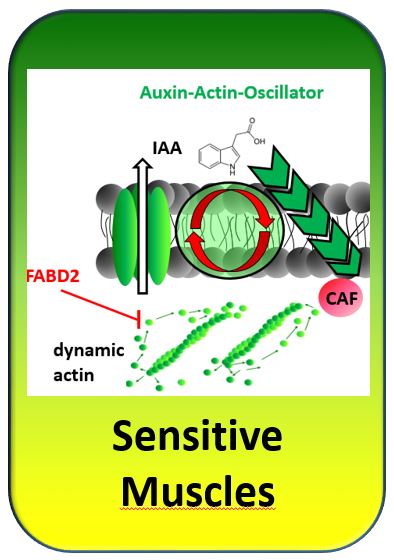2017_04: Sensitive Muscles
What is the topic?
Our muscles consist of a protein named actin, which assembles into fibers that slide by means of myosin motors. The resulting contraction of muscles is the secret of our mobility. Strangely enough, actin occurs also in plants, although plants do not move. Since more than two decades we try to find out, for what purpose. That actin can be used to move cargoes within a cell, is meanwhile well studied, but even very inert cells are full of actin that are mostly found below the membrane and continuously assembles and disassembles. Already for a long time we have reckoned that this actin is not a tool for movement, but a tool for sensing. Several years ago we could demonstrate an oscillator composed of actin and the plant hormone auxin. This oscillator helps plant cells to organise into organisms. This admittedly bold idea can explain many things.
Can we test this idea experimentally?
Although it is now clear that actin is very dynamic and that this dynamics are steered dependent on auxin, this does not mean that actin plays role in auxin sensing. If there were such a sensory function, we would predict that changes of actin should affect the cellular response of auxin. This is the idea, we test in the current paper. For this purpose, we have used transgenic tobacco cells, where an actin-binding protein, fimbrin, is upregulated. This fimbrin is linked with a fluorescent jellyfish protein (Green Fluorescent Protein), what allows to observe actin filaments in living cells. This fluorscence was only a side-product in the current study - more relevant was the fact that actin through the excess of fimbrin was a bit more lazy as compared to non-transformed cells. This allowed to investigate, whether these transgenic cells sense the auxin signal in a different manner. We had to make sure that the observed effects were not caused by the inability to respond to auxin, but by the inability to sense auxin (if a man in a dark room does not move to the opened door, because he has lost his legs, we cannot conclude that he is blind). Therefore, we have used auxin in different concentrations and then measured typical auxin responses.
What was the result?
In fact, many auxin responses in the cells with "lazy" actin were damped, especially those linked with cell division. How fast cells enter a new division cycle in response to auxin, how strong cells in a file synchronise their division cycles, how fast a nucleus moves from the cell periphery into the cell center to get chromosomes into position for separation, was dependent on the dynamics of actin filaments. Interestingly, there were also auxin responses that were accelerated by "lazy" actin. These were all responses important after completion of the proliferative phase. How strong cells expand by uptake of water into the vacuole, how fast cells in a file separate, or how fast they becaem ready for a new cultivation cycle, was dependent on actin dynamics as well, but in exactly opposite direction. In both cases, the normal responses could be triggered, when auxin signals were increased in amplitude. This means that the transgenic cells were able to responde to auxin, but they were simply not as sensitive as the non-transformed cells. In other words: the sensing of auxin was affected. In reverse, we can conclude: the cells perceive auxin (the probably most important hormonal signal in plants) by means of dynamic actin.
Publication
133. Huang X, Maisch J, Nick P (2017) Sensory role of actin in auxin-dependent responses of tobacco BY-2. J Plant Physiol., http://dx.doi.org/doi:10.1016/j.jplph.2017.07.011 - pdf

